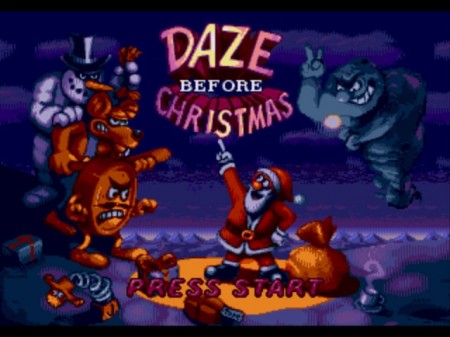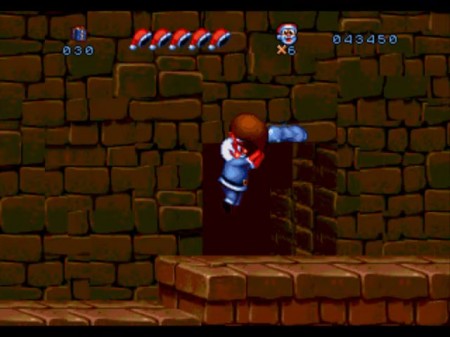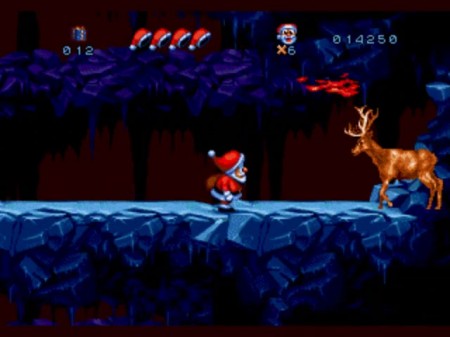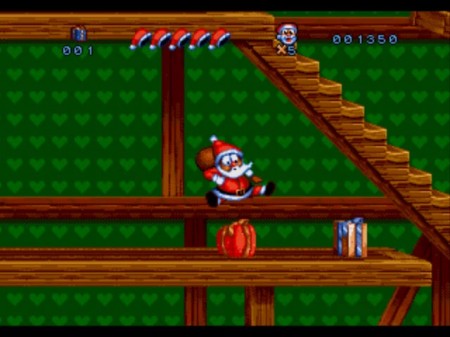Retro Reticule – Daze Before Christmas
The days are getting shorter, the nights are getting darker and the streets are getting busier, which can only mean one thing. It’s that most wonderful time of year again, it’s Christmas. While we’re starting to get festive though it’s easy to overlook that our favourite pastime is the grinch of the media world. During this time of year both music and film pump out hundreds of themed albums and movies, but while many games make a token effort (with DLC and such) fully-fledged Christmas games are few and far between. There are some though, like Funcom’s 1994 Mega Drive game Daze Before Christmas.
In this platformer it’s 24 days before Christmas and Santa is readying himself for the big day. Not all is well though as an evil snowman uses magic to make all of Santa’s toys turn evil. So it’s up to old St Nick to sleigh the snowman and save the day. To do this Santa has two attacks – ranged magic and a jump attack. Unlike in most games this jump attack isn’t automatic but requires a second hit of the jump button to activate. Most enemies are vulnerable to both the jump and the magic, making both attacks equally useful throughout the game. Perhaps even too useful, as while the enemies are visually interesting, none of them pose any real difficulty. More or less all of them have extremely simple movement patterns and die after just one hit.

The difficulty, or rather the frustration, in the game comes from two different sources. The first is the collectable presents that are scattered through each level. In the mid 90s there was a strange trend for making collectable items that have a seemingly random chance of turning into something bad. In Michael Jackson’s Moonwalker timed explosives hid in the same places as Annie, in Toejam and Earl: Panic on Funkotron bowling balls dropped out of bushes instead of kids and in Daze Before Christmas collectable presents contain bombs and enemies as well as well as friendly elves. This random element is a constant source of frustration, grinding the game to a halt as every present becomes a potential hazard.
The other main frustration is the controls. It makes sense that someone who eats a billion mince pies and drinks a billion brandies in one night would handle like a drunken mess, but Santa’s floaty jumps are more fitting of a feather than a fat man. Also, it’s clear that this depiction of santa enjoys the brandy a bit too much because one of the power-ups, a sobering coffee, turns him in the demonic anti-clause. A devilish depiction of old saint nick that is invincible to damage but unable to open any presents.

This detour from established Christmas lore is a running theme throughout the game. At the start, everything as one would expect a Christmas game to be. Early levels see Santa jump through homely houses and winter wonderlands, and the level select menu is an advent calendar, a little detail that really adds to the theming. Things go downhill though when the levels turn to the generic steel factory settings that were omnipresent in Mega Drive games.
It’s a genuine shame because Daze Before Christmas has some amazing little touches, like the aforementioned level select screens and the bonus levels which do away with platforming and take on a pseudo-sidescrolling shooter gameplay. Instead of shooting down enemies though Santa in his sleigh avoiding enemies and dropping presents down chimneys across a cityscape. These levels don’t provide much in the way of difficulty but provide an enjoyable break from the otherwise repetitive gameplay.

When Daze Before Christmas was released in 1994, the 2D platformer was in its prime and the game faced a tough market. Since the release of Super Mario Bros. on the NES the platforming genre dominated consoles until the introduction of 3D gaming. In ’94 the Sega Saturn was released while the PS1 and N64 were readying for their launches, and the Mega Drive already had a strong library of quality platformers, including the orignal Sonic trilogy.
Due to the popularity of the genre there were many functional but forgettable platformers for the console, which all feel similar to Daze Before Christmas. The only thing that sets Daze apart is its Christmas gimmick. Compared to the best games of the time such as Sonic 3 and Aladdin (both released a year prior in ’93) it’s an underwhelming and clunky game.

Time hasn’t been kind to Daze either. Not only were there better games than it when it was released, but the platforming genre has progressed greatly since ’94, thanks mainly to indie games causing a renaisssance of the genre in the late 2000s. Due to the relative ease of programming platformers and the high-profile successes of games such as Super Meat Boy and Fez, the genre is now once again one of the most popular and innovative.
Despite its flaws, Daze is a difficult game to stay annoyed at. Though its gameplay is generic, there’s a charm that permeates through the game, spreading Christmas cheer like a scent of cinnamon. If gaming took the holiday as seriously as music and film does, Daze Before Christmas would probably be forgettable. But purely for the novelty alone it’s a great bit of festive fun.